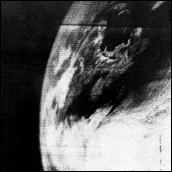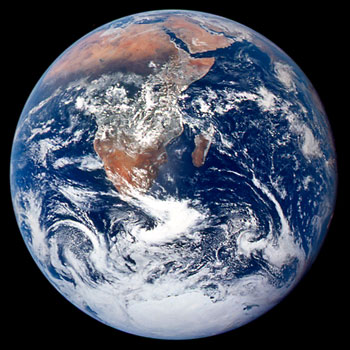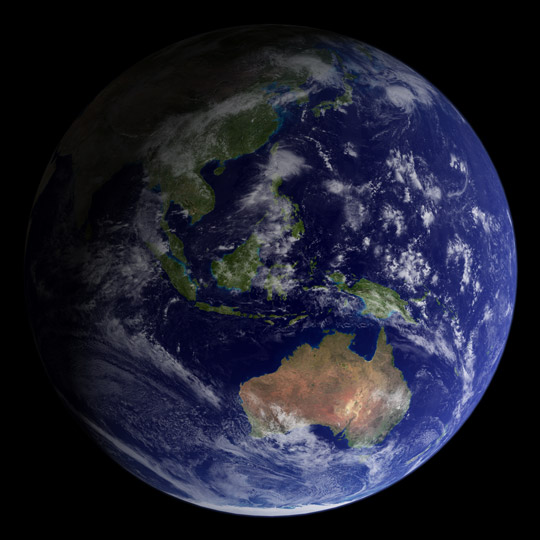

History of the Blue Marble |
|||
The Earth didn’t appear blue in NASA’s first satellite images; rather, the Television Infrared Observation Satellite, known as TIROS, beamed home images in black and white. Still, those earliest images showed that a yet-unproven method of observing the Earth from space would help improve weather forecasts. Astronaut photographs taken during the Apollo missions provided full-color images of Earth, and fostered a greater awareness of the need to understand our home planet. In 1972, from a distance of about 45,000 km (28,000 mi), the crew of Apollo 17 took one of the most famous photographs ever made of the Earth. This original Blue Marble inspired later images of the Earth compiled from satellite data. In 2000, NASA data visualizers compiled an image of the western hemisphere using data from the National Oceanic and Atmospheric Administration’s GOES-8 and Advanced Very High Resolution Radiometer, and NASA and Orbital Sciences Corporation’s Sea-viewing Wide Field-of-view Sensor. |

The first television image of the Earth from space, taken by the Television Infrared Observation Satellite (TIROS-1) on April 1, 1960. (Image by NASA) |
||

In 2002, NASA produced the Blue Marble, the most detailed true-color image of the Earth’s surface ever produced. Using data from NASA’s Terra satellite, scientists and data visualizers stitched together four months of observations of the land surface, coastal oceans, sea ice, and clouds into a seamless, photo-like mosaic of every square kilometer (.386 square mile) of our planet. In October 2005, NASA released a new version of the spectacular image collection that provides a full year’s worth of monthly observations with twice the level of detail as the original. The new collection is called the Blue Marble: Next Generation. |
On December 7, 1972, the crew of Apollo 17 changed the way we look at our home planet. This photograph illustrates the Earth as an isolated ecosystem, floating in space. (Astronaut photograph AS17-148-22727 courtesy NASA Johnson Space Center Gateway to Astronaut Photography of Earth) |
||
 |
|||
Like the original, the Blue Marble: Next Generation is a mosaic of satellite data taken mostly from a NASA sensor called the Moderate Resolution Imaging Spectroradiometer (MODIS) that flies board NASA’s Terra and Aqua satellites. Also like its predecessor, the new Blue Marble is available free of charge to educators, scientists, museums, businesses, and the public. The collection includes images that are sized for different media, including Web and print. Users can download images of the entire globe, or just selected regions of interest. |
The 2002 Blue Marble featured land surfaces, clouds, topography, and city lights at a maximum resolution of 1 kilometer per pixel. (NASA image by Robert Simmon and Reto Stöckli)
|
||

|
The Blue Marble: Next Generation features imagery of land surfaces during each month of 2004, with a maximum resolution of 500 meters per pixel. (NASA Image by Robert Simmon and Reto Stöckli) |